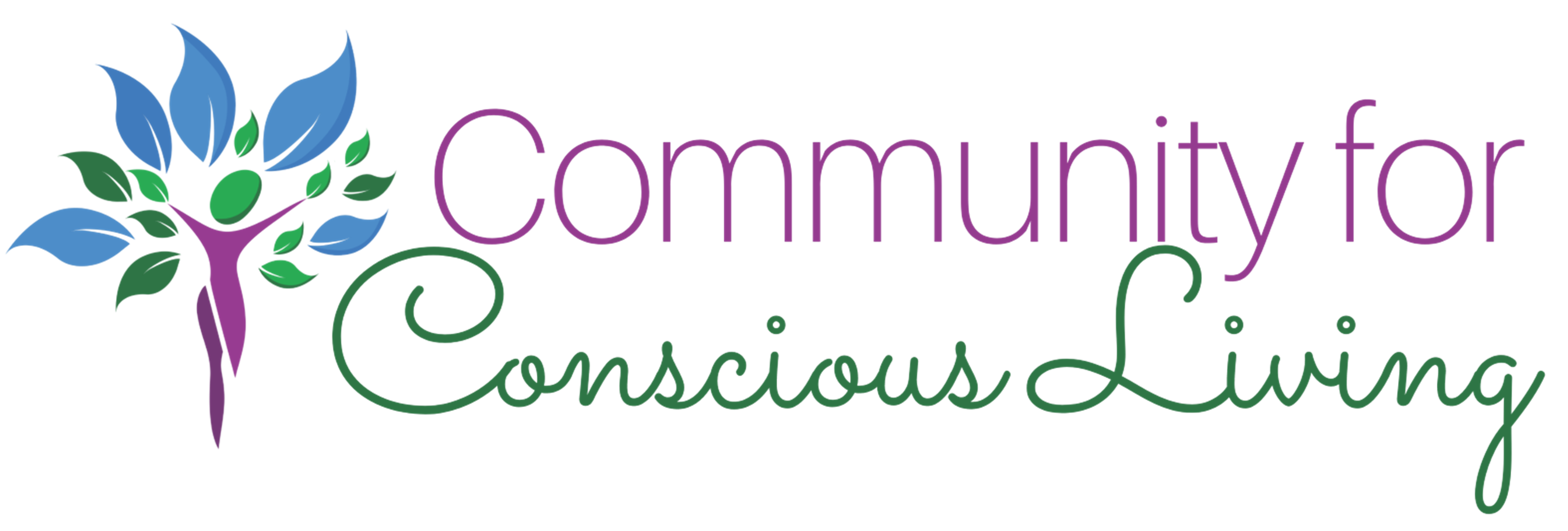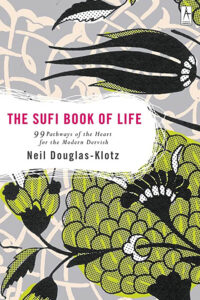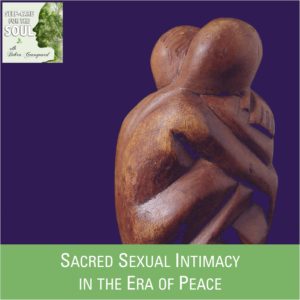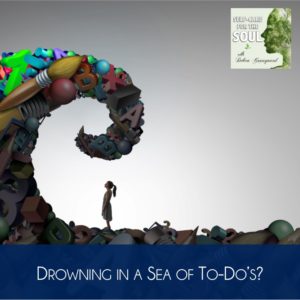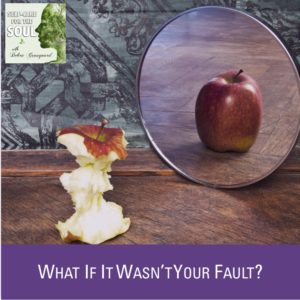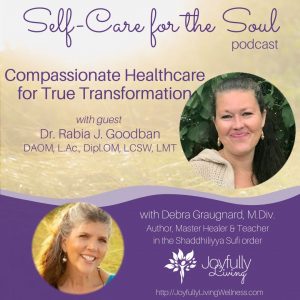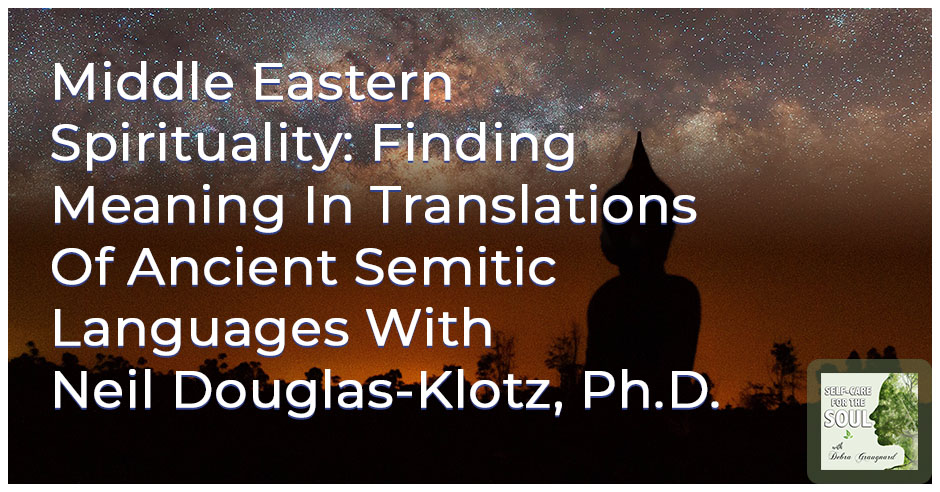
Part of practicing spirituality is finding that connection. For most, you can only do that by understanding the religion or philosophy, especially when they go back to ancient languages. This episode’s guest, Neil Douglas-Klotz, Ph.D., is someone known for the translation and interpretation of the ancient Semitic languages of Hebrew, Aramaic and Arabic. He is also a renowned writer, teacher and artist in the fields of Middle Eastern spirituality. In this interview from the Ocean of Sound Summit, Neil speaks on Middle Eastern Spirituality. He helps us gain a deeper understanding of spiritual teachings through the interpretation of ancient Semitic languages. Follow along to this insightful conversation and learn more about Sufism, what is often lost in translation, and the connection with sounds and breath work.
—
Listen to the podcast here
Watch the video here
Middle Eastern Spirituality: Finding Meaning In Translations Of Ancient Semitic Languages With Neil Douglas-Klotz, Ph.D.
Our guest is Neil Douglas-Klotz. Amany and I are very excited to have him with us. Neil Douglas-Klotz PhD is a renowned writer, teacher, and artist in the fields of Middle Eastern spirituality, and the translation and interpretation of the ancient Semitic languages of Hebrew, Aramaic, and Arabic. Living in Scotland, he was for many years the co-chair of the mysticism group of the American Academy of Religion.
He is a frequent speaker and workshop leader. He is the author of several books. His books on the Aramaic spirituality of Jesus include Prayers of the Cosmos, The Hidden Gospel, Original Meditation: The Aramaic Jesus and The Spirituality of Creation, Blessings of the Cosmos, and Revelations of the Aramaic Jesus.
His books on a comparative view of native Middle Eastern spirituality include Desert Wisdom: A Nomad’s Guide to Life’s Big Questions, and The Tent of Abraham with Rabbi Arthur Waskow and Sister Joan Chittister.
His books on Sufi spirituality include The Sufi Book of Life: 99 Pathways of the Heart for the Modern Dervish. I use this as a daily reference book, and The Little Book of Sufi Stories. He also edited four collections of the work of Middle Eastern mystic Khalil Gibran, another one of my favorites.
He has written a mystery novel set in the first century C.E. Holyland, entitled A Murderer at Armageddon. I didn’t realize that one was a part of your library or your repertoire as well. I want to welcome and thank you for being here.
Thank you both.
It’s an honor. We’re excited and a little bit starstruck because we have used your books as a reference and daily guides for myself. I want to introduce Amany as well. She’s been a beautiful friend for a long time. She was a translator for twelve years for my spiritual teacher, Shaykh Muhammad Sa‘id al-Jamal ar-Rifa‘i ash-Shadhuli from Jerusalem.
Amany has her Master’s degree in the Comparative Philosophy of Religions. Her postgraduate is in Islamic Studies in Sufism. She is the founder of Universal Chaplaincy. I have been certified as a chaplain under her program as well.
She and I co-teach a program called The Ocean Of Sound. We get to dive into all the mysteries of sacred sound and everything as much as we can in our little drops of ocean, delving into the mysteries, deeper meanings, and beauties. Welcome, Amany and Neil.
Welcome, Neil. It’s an honor and a pleasure to have you here. I have to confess, I raised my children on your book, The Sufi Book of Life. It was a part of our daily practice and use. I wasn’t very interested in the sound parts back then, but now I am. There is always something new to find in the book. How did you become interested in Middle Eastern classical language, interpretation, and sound? How did you start?
I don’t want to tell you my whole life story but I was always somewhat interested in languages because I grew up hearing various languages in my family. These were not Middle Eastern languages. Although, I was raised in the United States in the Chicago area.
My parents and grandparents spoke a form of German. My grandparents on one side also spoke some Polish, Russian, and Yiddish as we found out later. As a child, I grew up hearing these different languages. That predisposes me to be interested in languages, translation, and these sorts of things.
When I went to university, I ended up with an undergraduate, majoring in both English and German. Because one can’t make a living very well from these things unless one goes into teaching, and as many youths did in the ‘70s, I wanted to change the world so I became a journalist. I became an investigative reporter. I went to work young and fresh out of university in New York City. I was hired. I guess I was good.
I learned all the tricks of investigative reporting. This is before the internet. One had to understand how to cultivate sources and get people to tell you things they didn’t want to tell you. It’s a particular skill to look up things and be able to read various texts and government documents very fast, just skim through them and pick out what’s true and what’s not.
This was perhaps a predilection from my childhood that I wanted to find out and know more about. That’s where it came from. My parents were seekers of the sort. Although we were raised Christian, they were more interested in holistic health and the early ecological movement in the US, which was based around Rachel Carson.
They were also interested in this American channel, Edgar Cayce, who you may have heard of, especially if you live in the US. There’s still a Cayce Foundation and many remedies that Cayce recommended in his channelings. My father was interested in all of that so he educated us in all of that.
I remember I had a university professor in undergraduate in World Religions. When he came to Islam, he chose to emphasize some of the early translations of Mevlana Jalal ad-Din Rumi by Arberry and Nicholson. Mostly in the ‘70s, that’s what was available. I became very interested in the Sufis early on. I then put it aside because in the university you’re not that interested in religion. You want to change the world. At that time, I had been raised with some religion and I was sort of, “Not really.”
I went to work as an investigative journalist first in New York, and then later I was in Denver, Colorado. I became disillusioned and disenchanted with even if you presented people with the facts of a situation or if you reported the facts, they didn’t necessarily act on those facts.
Even if you present people to the facts of a situation, they don’t necessarily act on those facts. Share on XI suppose I should have known this as a young person in my mid-twenties, but somehow this struck me at a certain point. I became very depressed and I went on my own spiritual and psychological search. How do I make decisions? Do I always make decisions based on facts? I don’t know what the facts are half the time when I make a major life decision.
At the time, when I was living in Denver, I went to various spiritual groups as they were at the time. This was the late or mid-1970s, and there wasn’t that much to offer. I wasn’t enchanted with any of them, then I read a book by Idries Shah on The Sufis. Although there were no Sufis in that area at the time, I began to research because I knew how to do research.
“Where are the Sufis? Who are the Sufis? Where are they? Is there anyone in the US and North America?” I ended up visiting the event of a group in California that was a branch of the Chishtīyah Sufi lineage.
For your audience who may or may not know, the Chishtiī Sufis’ titular founder, Mu’in al-Din Chishti, moved from present-day Persia, Iran to some area in Northern India. He ended up landing in Northern India at a particular time when the Chishtiīs ended up being very influential on the Mughal Empire, not the Mongols.
There was a multi-faith and interfaith understanding at that time. Mu’in al-Din Chishti was very much favorable of this. Some of the early Chishtiī Sufi saints were involved in formulating the Indian science of Raga. That is the science of sounds of chanting.
When I ended up with this particular Sufis, they were doing chanting and movement. They were using music in a sacred sense, not in a secular sense, along with chanting. I began to have very deep experiences from that.
Originally, I thought, “I’ll get a nice journalistic article out of this even if it’s not anything.” It’s just another dead end for me personally. I was doing some of this chanting and movement. I recall we came to the end of a particular chant. We were holding hands as sometimes one does in various Sufis. I completely lost consciousness of where I was. I went out of my body temporarily, then I came back probably 30 seconds or 1 minute later as a spoken prayer is being said. That got my attention.
I had been mainly a very intellectual person, as you can probably surmise, up to that point because that’s the way I made my living. This is the way I was trained, writing, languages, research, and all of that. This brought me more deeply into my body and my heart, and then it got my attention. I went more deeply into this.
This was the start for me in some ways. I’ll finish briefly this because I was still somewhat of a suspicious person. I didn’t trust the translations that these people were giving me, Sufis, Quran, or anything else. I began to learn something about the Semitic languages at that point.
Were they chanting them in Arabic?
Some Persian but mostly Arabic. It was pretty elementary, but there were beautiful names. Al Asma ul Husna is some of the 99 most beautiful names. Some that are not in the 99 lists, but are some of the other beautiful names in the Quran, were being chanted. Also, various forms of Kalima, La ilaha ill Allah Muhammadur-Rasul Allah, and the other traditional Kalimas in the Chishtīyah traditions.
When I was first learning as well, I had that same suspicion. I don’t want to just chant something when I don’t know what I’m saying. I did the same thing. I’ve got to understand it in English first, and then learn more about the translation. When I could feel comfortable with it, put my heart into it, and let go of the guardedness, that’s when the miracles begin to happen. Things start to open up.
When I found your book with each one of the beautiful names, it has a section called Roots and Branches, which expands on the individual sound codes and how they come together to form the meanings of the names. That has allowed me to take the study even deeper into my heart and become even more passionate. I appreciate that immensely.
There’s a long journey between what I told you and when I was working with the 99 names. I began to look at the Chishtīyah tradition of sound, which can be found in its most clear form in English in the words of Hazrat Inayat Khan.
He has a book on music and sound. I began to investigate this. It was clear that sound was not just words spoken that you would look up in a dictionary. There was a vibrational aspect to the sound, especially sacred sounds.
These sacred sounds could be Arabic, Persian, or Hebrew. Later, I found that Aramaic was a real doorway. The spoken Aramaic of Jesus is very important because it is a hidden key to what Jesus is talking about in the gospels, but also Sanskrit and a number of other languages that are traditionally chanted. I began to investigate this more and more deeply.
Did you start to self-study or you started with a particular teacher of the sound topic?
I first studied with a Quran teacher originally. He was from Pakistan. We brought him over to teach us Quran because he was a friend of the lineage teacher of our order. He spent a month going through the first surah, Surah al-Fatihah, and going over and over. We said to him, “You are giving us all these different meanings. Which meanings are the literal meanings?”
He said, “They’re all literal meaning.” That’s because there are layers and layers. If you look at the root this way, it’s this way. If you look at it this way, it’s this way. You have to feel what it is for yourself. Before he went back to Pakistan, I said, “Let me sit you down with a tape recorder, and let me go through this list of the 99 names with you.”
I won’t mention which translation I use, but I used one of the accepted translations of the Al Asma ul Husna. He would say, “That’s not bad but that one is completely wrong. That’s terrible. That’s very dualistic.” It would say, “Do this many times and your enemy will drop dead,” or these sorts of things that one finds in some of these texts.” He said, “It’s not that.”
I made some notes and then put that aside. I’ll return to that later because that seems important. In the meantime, I got very involved with the Aramaic words of Jesus. This is in the late or mid-1980s. When I was doing an editing project, the lineage teacher of our particular transmission, Samuel Lewis or Sufi Ahmed Murad Chisti had written that he wanted to learn to pray the Lord’s Prayer in Aramaic.
He had never done that. No one could remember him having done that. I began to follow that up. I had a Christian background and I knew the Bible quite well, then I was intrigued. This allowed me to go more deeply into not just Arabic but also Aramaic and Hebrew almost simultaneously. Some with academic study, some with study with personal teachers, and some with Jewish Kabbalah teachers to look at different ways in which you could triangulate the meaning.
This led me to get this PhD in what became Ancient Semitic Language Hermeneutics, which is the science of interpretation that is present in ancient Semitic languages. There is a unified field of the way of interpreting the roots.
If you go back to the ancient Semitic roots, the different translations, for instance, that we have with the 99 names in the various books that you can find, you can see how the ancient Semitic roots make sense of all this, but also give the experiential meaning. It shows an open doorway and how to go deeper.
You don’t just stop with the merciful, the compassionate, or something out there. This is the reality that is seeded within humans. This is very clear when reading the ancient Sufis. These things are not things. These are not just quality attributes out there in some transcendental universe. These were seeded into the human at the beginning or creation, and it’s up to us to bring them out.
You found a common thread between those languages because they all stem from the same origin and have things in common.
They all come from a very simple system that comes out of the ancient Middle Eastern people’s nomadic experience. That means pre-agriculture. They were simply traveling and following where their ancestors had gone. They were hunter-gatherers using the common terms now
In Southwest Asia, the language develops in a particular way such that individual sound like the sound, “Ah,” creates a relationship with something that is both within me and around me or outside of me. “Eh” is more of a held breath as we have in classical Arabic. This is more of a breath that is too trapped within my individual self. The original root in the Semitic alphabet is 1 letter, not 2 or 3.
Each letter is like a living being that is Allah, or whatever you want to call that, speaking through us. This is how these languages evolve. It’s not through grammar. Grammar happens only later. This is a thing I point out more deeply in my book, The Revelations of the Aramaic Jesus. Grammar comes much later, just as it does when we are children.
It was in the childhood of humanity. We begin speaking and emulating our parents. We understand what a sound means, even if it’s not a real word, an English word, or another language. A sound indicates the relationship it makes. Gradually, we learned sounds from our parents by speaking, relating, and using them. Later when we go to school, they tell us, “You can’t speak that way. You have to speak this way because this is the grammatically correct way to speak.”
Each language, particularly the Semitic language, goes through the same developmental process. This is extremely important. By that time, someone like Ibn Arabi understands this intuitively because he’s a great mystic. Ibn Arabi said that the beautiful names, Al Asma ul Husna, are not things. These are not even God’s name, so to speak. These are our names for those names.
The real names are god’s or Allah’s activities within us that are always going on. These activities of Allah that are always going on within us are numberless. It’s not 99 or 999. They are numberless, and not only in us humans but in all beings around us or nature. This was the ancient Middle Eastern understanding.
I love when you said that we learn in our childhood development. When we go to school, it’s like this grammar is the way that we are supposed to speak and structure our language with each other. It takes us from that sense of being, feeling, and communicating from that place up into the head of like, “Here’s how I have to do it right.”
As you were saying, it got a sense of the disconnect and how the disconnect comes into our language and our communications. We begin to lose that natural connection or that connection to nature and how we communicate our feelings and our sense of connection with our environment.
That’s on a personal level. On the more global level, the Arabic that is spoken through Muhammad, Sallallahu ’Alayhi Wa Salam, as the Quran comes through him, also does not yet have grammar. It does not acquire classical Arabic grammar for at least a couple of 100 years after his time.
It’s influenced by various influences, not least of which is the fact that Islam by that time has become an empire. The grammar that is composed at that time, which stipulates a three-letter root for each Arabic word, has this tendency to greatly limit the meaning of a particular Arabic word or put it into a particular channel.
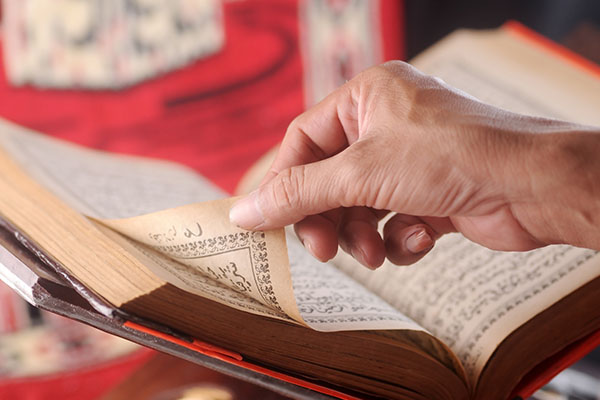
Any particular channel that worked is more of a philosophically platonic model. That is where the transcendent is up here somewhere, and the poor, flawed, and everyday world or the imminent were down here. The divide between them becomes greater and greater. This was an influence.
It suited an empire just as it suited the Christian colonial empire to misinterpret Jesus’s words. If you look into the Greek more deeply, these words were misinterpreted and mistranslated almost deliberately to support colonialism, racism, and a lot of other things that empires tend to be involved in. I’m sorry to be blunt about it but that’s what happened.

It’s true. We need to understand what happened.
On a personal level, you could say the inner sound, the meaning, or the relationship is still there in the sacred words, but one has to get through layers of things.
It’s going back to the sounds and letting go of the higher. I know that for myself. It’s difficult to just read the translation of the Bible, Quran, or any of the sacred texts, and take them word for word on the surface level. It’s hard to get through them in that way.
I have found that by saying, “That’s here. Now if I can just drop down and down,” then that’s where you can start to feel that connection with sound, deeper meanings, environment, nature, cosmos, or whatever mysteries that want to be unveiled. As you said, there are many layers.
I feel like I’m such a newbie to this. I did study with my spiritual teacher since the ’90s. I’ve been in it for a while and I still feel such a newbie uncovering more every day. There’s so much, which is the beauty of it. The beauty of the mysteries never ends. They are numberless.
In the last 15 or 17 years since I wrote The Sufi Book of Life, I’ve been helped enormously by Shaykh Abdullah Al-Harariyy who lives in South Africa. I’ve worked with him personally. I’ve gone to South Africa. He has come here to Europe and the UK. He encouraged me in this regard. He liked The Sufi Book of Life, although he has his own book on Al Asma ul Husna, the beautiful names.
He would say to me that Saadi is my Sufi name, “What’s the Semitic root for this word in Quran?” He’d be doing a live commentary and I said, “I’ll look it up.” He said, “I want to know all of the mother names of the main words in the Quran.” I began finding more and more of them. This was even after I did The Sufi Book of Life. I am working on a sequel to that book, although it’s going slowly with other very important sacred words that are in the Quran. This is with Shaykh Abdulla’s help and his ongoing support for this way of looking.
For the sake of our audience, it will bring more feeling and understanding if you can give us an example of a word and the layers and the mother roots that we were talking about. Would you please give an example or two?
One of the most commonly known given examples, many people know that Ar-Rahman and Ar-Raheem both come from the ancient Middle Eastern root word rham or something that’s coming from a womb. This is a word that is common to ancient Hebrew, ancient Aramaic, and also the original classical Arabic. We know that Ar-Rahman and Ar-Raheem begin all of the surahs of the Quran except one of them.
You could say that this is an ancient understanding that love and compassion are forms of inner birthing and radiating. If we feel the sound, “Ra,” it goes back even to the Egyptian sun god Ra. Egyptian also is a Semitic language, which is ancient Egyptian. Rham is a radiation or a ra from hmm, which comes from deep within.
You meditate with or feel the sound, “Hmm.” We use it as a nonverbal sound even today when we’re not sure what to say. If someone says something, I say, “Hmm,” as if I don’t believe it or I am surprised but don’t know what to say. Something wants to come from within, and this is radiating from the within-ness or this hmm-ness.
It’s no surprise that the root hmm goes back also to the ancient sound that indicates Sophia or Ḥoḵmā or al-kīmiyā in Egypt. Ḥoḵmā in Hebrew is the name for holy wisdom, and then later we have it come into the beautiful names as Al-Hakam and Al-Hakīm. It was divided into these two, but they all go back to this hmm. Aramaic has its own examples.
It seems to me that this symbol sounds and the way you represented it, you do it naturally without thinking. It is an authentic way of communication.
Take for instance the sound uh. It is another sound of surprise. I might say, “Uh,” if it’s something I feel very deeply or a deep surprise. In the Semitic languages, this goes into this connection between my individual self or my nafs as it’s called an Arabic, nephesh in Hebrew, or napsha in Aramaic. It’s the connection between my individual self and empowerment which created myself or my soul or my ruh. They are similar words in Hebrew and Aramaic.
This uh sound is this moving back and forth sound. This is why it’s part of the word ruh because it also means breath. It’s one of the many words for breath, but it’s the big breath. It’s not my personal breath that I’m holding on to in my body. This is the breath that is within the breath. Kabir talks about the breath inside the breath. It’s this sort of thing.
All the Sufis speak of this. Listen to the sound of nephesh or the nafs in Arabic. It’s an n with a ph sound, which is up in here. It’s like a held breath. It’s a word for breath because we have the word anfas and nafs, but it’s the personalized breath. It’s the breath that is held in our bodies for a certain number of years in this flesh.
The personalized breath is the breath that is held in our bodies for a certain number of years in this flesh. Share on XWe don’t know however the holy one wishes, Inshallah, but it’s that personal breath, which is held in these bodies for however many years in time and space we have. We’re supposed to remember that there’s a bigger breath. These are some of the things I’ve gone into more recently. They’re very important,
It seems to me that it is one way to read about it, and one way to hear it from someone who has been studying and living it. The written word is limited in the way it will communicate the deep messages behind the sounds.
It’s very true. This is why I have these little attempts at experiential contemplation in the book. As I say in the introduction to The Sufi Book of Life, I had inner permission and also outer permission from my spiritual teacher at the time, who is no longer in the body, to do this because people have to start somewhere.
It’s also because I was not being prescriptive with it. I wasn’t saying, “If you do this name so many times, you will get this goody at the end.” Some books do that even more insidious. They say, “If this is wrong with you, then this is the antidote.” It’s sort of Freudian psychological sense. It’s like you’re patching holes in your head with these beautiful names. This is a very popular approach. I’m not saying it’s not helpful for people. There’s no question it can be, but it’s not my approach.
In The Sufi Book of Life, I would say, “If you happen to be drawn towards this beautiful name or guided to it by your personal guide, I recommend having a personal guide, if you’re drawn to it by opening the book at random and breathing in the heart, you may be experiencing this in your life. “
These may be challenges you’re undergoing. This may be happening around you. Try this name and see where it leads you. I’m not telling you where you’re going to end up. See where it leads you. They are all doorways. They are all a part of Tawhid that is coming to this unity that Ibn Arabi and so many Sufis speak of. It all starts with toning a sound in the heart. You don’t need 99 or 10 names. You maybe need one.
You need the deep sincere. My teachers talk about the deep sincere.
It’s 90% the deep sincere. If you’re in deep need or in trouble, that creates deep sincere. One has to cultivate it with devotional means.
It’s also a personal thing. It is not a standard solution for everyone like, “If you take this and do this with it, this is the result.” It’s more of an individual connection to it and a connection to Allah.
It is absolutely that. Rather than saying, “I know I need more of this quality or I have this problem. This is going to solve this.” It isn’t necessarily going to work that way. As Rumi, Ibn Arabi, and many of the great Sufis point out, one has to cultivate that individual connection you’re pointing to, Amany, because the different names are active within us.
The different sounds, the activities of Allah, or the great mystery are active within us every day differently. The voice of the Quran says, “Every day I’m about something different. Every day I’m doing some different activity.” The Quran says it quite clearly. This is the way it works.
One of my favorite teachings is that when the breath is breathed into the body, this is like the ocean in a drop. The meanings of all of the names of everything in creation are breathed into us, and everything in creation has a breath and has a sound.
The intentions I like to make when I call them the sacred sounds and the divine names is the meaning that was given to me with my breath. It’s illuminated, awakened, and clarified for me so that I can come into wholeness through that knowledge that, god-willing, is there to be awakened.
We’re here to be representative of spirit and form as best we can in our human bodies through our human ego selves, just to have the desire and the knowledge that we’re still human, but the desire within that knowledge of the limitations of our humanity.
To have that yearning is something that can draw us closer. It can bring healing to the heart when the heart is missing something, and can perhaps extract meaning or some form of healing or wholeness through invoking a sound and allowing that vibration to carry us or carry our hearts or souls to wherever we may be guided or being guided to at that time. It can be a very healing experience.
Mashallah. That’s beautiful, Debra. It’s like a short version of what Genesis says. When the first breath is breathed into the human being, we’re supposed to be responsible for, and realize we’ve downloaded the breadth of all of the beings created before us in the previous days.
We’re not supposed to dominate and rule over them. That’s another terrible translation of the Bible. We’re supposed to feel ourselves within them. It’s a big difference between over and within. It’s a mistranslation of the Hebrew.
I often say to people to start wherever they are, in tone on one note. Don’t worry about what note it is musically. I had an Indian music voice teacher said, “One note is always in tune. You cannot be out of tune. Each person has their note.”
One note is always in tune. You cannot be out of tune. Each person has their note. Share on XHe says that each person is a note in the universal symphony of life. Find your note. That means literally that when you’re in toning, feel the sound, high or low, or whatever experiment until you feel your heart resonating. It’s that simple. It doesn’t have to be complicated.
It is something you know and feel. It’s not like it imposes from the outside. For example, sacred phrases. You can chant it until you find your tone. That will have an effect or impact on you.
Once you found that heart voice, you’re feeling yourself in the heart more than you’re hearing yourself. This is very important. Feel yourself before you start to hear yourself because our hearing is sometimes layered over with all of these messages, “I have a weak voice, this or that voice. I was told to go sing in the corner,” this nonsense that children are told in school. Feel a heart voice, then you always have a friend here. You can then sing with other people because you know you can always return home. Find that home. This is what the Chishtiī Sufi says.
I know that the translation or the interpretation of the Lord’s Prayer in Aramaic is something that I sense you’ve been very passionate about. Can you give another example from the study that you’ve done or that interpretation that you’ve done? I would love to hear something from that.
This is where I began the deeper work into the Semitic languages. I had studied some Arabic before, but it was Aramaic that allowed me to go more deeply into this. For instance, the usual translation of the first line of Jesus’s Prayer in King James English as it’s well known is “Our Father which art in heaven.”
The Aramaic says, “Abwoon d’bashmaya.” This is much more of a process than it is a being. The ancient nomadic languages were strong in this. Abwoon, which some people commented sounds a little like oohm but his different. Abwoon is from the source of all, from God, or whatever you want to call that. It is coming like a breath to us and is giving birth to us. It’s the sound bait or be in Semitic languages, Abwoon. It’s resonating here now in this body.
Breath is always new. Creation is always happening. It didn’t happen seven thousand or a hundred thousand years ago. It’s always happening. This same breath is spread throughout, not somewhere up here. It is d’bashmaya. Two prepositions here. D means moving from and to somewhere, but also it’s within somewhere.
Where is it moving from and to, and within? It’s a realm of shm or of light. It’s a vibrational form of light. It’s different from the newer but related to it. The shm is the wave reality that physicists speak about. It’s no surprise that we have the same shm in a later form in classical Arabic sm, as in Bismillah, with the name, with the light, with the vibration of Allah, and with my next breath in this vibration. I’m taking my next breath, step, and action.
This is why we say Bismillah at the beginning because that’s our sincere intention. This is an example from the first line of Jesus’s Prayer. The rest goes on and on through this. There’s a whole chapter in my new book about this, but also in my earlier book. The new one is much better.
The first word is Abwoon.
The B and the W sound are one sound in ancient Semitic, ancient Aramaic, and ancient Hebrew, not modern Hebrew. This ruh means both within and among. We only have one preposition in the ancient Semitic languages. That which is within me is also around me. I’m among them.
This immediately tells us within and among. There’s a connection between what I consider my inner world and what is around me or nature. Ancient humans understood this quite clearly. We forgotten. We think, “My inner world and my psychological world have only to do with me, and nothing to do with anyone else,” but we know that’s not true.
It reminds me of one of the things that we’ve been studying with the, “Ooh.” It is also a realization or a recognition of the divine beauty, and how beautiful is the world when we recognize and see the divinity within that which is around us and within.
If we talk about the 99 beautiful names, which are mentioned in the Hadith of Prophet Muhammad, sallallahu ‘alayhi wa sallam, each of these is a doorway to go to or travel. We’re not supposed to stop there or stop with any translation, including my translations. Find your own relationship to it.
There is a range of meanings. I try to help people get into that range. You could say the ancients felt this sound cradled them, not just from the time of Prophet Muhammad, but for thousands of years before. These mother names are cradling humanity’s understanding of the universe around them, and how that relates to what they feel is beginning to feel within them.
It is like once the individual has resonated with the cosmic. This initial sound that began was like that. They were already immersed in nature and the cosmos. They read the phases of the moon. They were very connected. We became very disconnected. We almost also lost the meaning of the sounds and their depths.
The change in our human consciousness happens very gradually. We don’t notice it because we’ve only lived in these forms in this body. We’ve only lived this lifetime. If you’ve lived a certain number of years, you see that our culture has become more self-oriented or modern culture. I call it selfie culture.
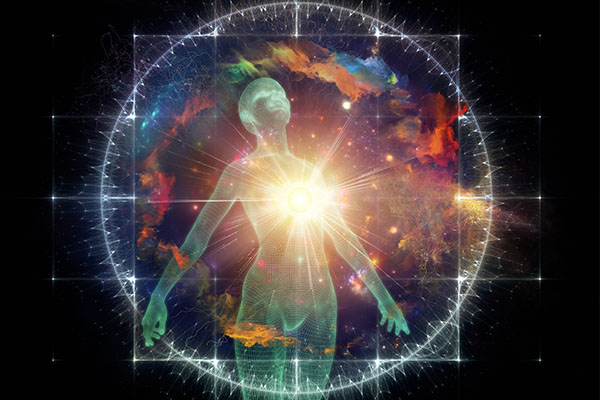
This has led to many problems. Even 400 or 500 years ago, much less at the time of Prophet Muhammad, Jesus, or these folks, the human self was not isolated within itself. It was much more connected. Thich Nhat Hanh, the Buddhist teacher, talks about, “It was more of an inter-being that we had with what is around us.”
Now we need spiritual, chants, meditation, breathing, awareness practices, or whatever we can use to bring us back in a new way to where our ancestors already were. Now we have this human self. How are we going to use our human self properly? This is the question of the day.
I feel like humanity and our planet can’t go too much farther into the separateness than we’ve gone without a strong contraction back. I’m seeing it even more and more as a way to bring us back to that connectedness with our deeper inner selves, as well as nature, the cosmic, and the breath or the ruh.
It goes back to the basic foundation of your being.
Everything is right in front of us now. We see the effects of this trend towards a more isolated sense of humanity or a more isolated sense of self. There’s a large rise in mental illness, particularly among young people because they don’t see a purpose in life. However, one can rediscover this connection through chanting and meditation, and through work with ecology. Young people work deeply in nature. All of this helps because they’re breathing more of a natural breath. It’s very important.
It brings clarity around the powerful healing that we can get from that.
Whatever we individually can do, we do. We don’t have to do what everyone else is doing. You’re both doing this show and the summit. That’s great. You will touch people that I never would. I am now. You understand what I’m saying. What one does and what one can do in everyday life, and what one is called to do are very important.
One does what one can in one's everyday life and what one is called to do. Share on XAs a final wrap-up to this beautiful discussion that we’ve had, and I appreciate it so much, is there advice that you would like to give to people who are feeling inspired to tap more deeply into this experience within themselves or of sacred sound and the deeper meanings? What advice would you give or anything that you would like to say to the people?
If you feel a need and you feel drawn to this work called sacred sound or sound, begin with something reliable. Begin with one of the beautiful or essential names that Jesus uses which are in my books, or essential names in Hebrew or another language like Sanskrit.
Find in yourself where that heart voice is or where that resonance is, and then find the need. This is what Mevlana Jalal ad-Din Rumi says, “Increase your need so that Allah can increase his gifts to you.” That doesn’t hurt. It’s not difficult to find a need, whether they’re our own, our families, or personal needs. Needs are all around us. Find a need, feel that, and then go from there.
As Rumi said, “The crack is where the light goes.” If we are in need, this is where we are empty to receive.
The light needs the darkness to go into it. In our realm, our time spells space. We need them both. Even the verse of light says this. This is quite clear from that.
We would love to have you again, Inshallah, for more about these topics.
I’m happy to anytime. I appreciate your inviting me and the work you’re doing. It’s very important. It’s very rare that I get asked about these things. Most people want to know about the meaning of this, that, the other thing, and all of that.
That’s important too because it gives people an experience or an excuse to have an experience, which is my main affirmation. “Here’s an excuse to have your own experience,” but in terms of the actual sound and all this, there is so much that is there. I’m glad you’re doing a longer series on this. Mashallah, Inshallah, it will go very well for you.
Thank you so much. I appreciate everything that you’ve shared and given. Knowing a little bit more about your journey, your life, and how it has evolved for you are very inspiring. It has inspired me to continue to dive deeper and expand my knowledge. I love what you said about the need. When we allow that need to deepen within, it’s what sparks that yearning. The tractor beam draws us to that resonant home note. It all goes full circle.
I want to let people know how they can reach you if they want to learn more about what you’re doing. The Sufi Book of Life and The Aramaic Jesus, which I’m diving into and loving it, can be found on your website, Abwoon.org. You also have a Facebook page, @AuthorNeilDouglasKlotz.
If people go to my website and dig further where people don’t usually go, you’ll find in the library an index of chants. You can hear me doing various chants from beautiful names and things like that. It’s there. You click on it and you can hear some teaching. Usually, there is a translation in German because I was teaching at a summer school in Germany, where it’s English-German. All those things are there and many chants are there too.
I appreciate so much what you have done and the resources that you have available for us. Thank you. I want to say to the audience to stay tuned. We have more interviews coming in this series. We look forward to seeing you at the next one. Thank you.
Thank you, both.
Important Links
- Prayers of the Cosmos
- The Hidden Gospel
- Original Meditation: The Aramaic Jesus and the Spirituality of Creation
- Blessings of the Cosmos
- Revelations of the Aramaic Jesus
- Desert Wisdom: A Nomad’s Guide to Life’s Big Questions from the Heart of the Native Middle East
- The Tent of Abraham
- The Sufi Book of Life: 99 Pathways of the Heart for the Modern Dervish
- The Little Book of Sufi Stories
- A Murderer at Armageddon
- Universal Chaplaincy
- Abwoon.org
- @AuthorNeilDouglasKlotz – Facebook
- https://Joyfully-Living.MyKajabi.com/theoceanofsoundsummit
About Neil Douglas-Koltz
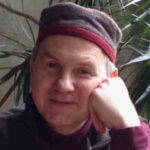
Neil Douglas-Klotz, Ph.D. is a renowned writer, teacher and artist in the fields of Middle Eastern spirituality and the translation and interpretation of the ancient Semitic languages of Hebrew, Aramaic and Arabic. Living in Scotland, he was for many years the co-chair of the Mysticism Group of the American Academy of Religion.
A frequent speaker and workshop leader, he is the author of several books. His books on the Aramaic spirituality of Jesus include Prayers of the Cosmos, The Hidden Gospel, Original Meditation: The Aramaic Jesus and the Spirituality of Creation, Blessings of the Cosmos and Revelations of the Aramaic Jesus (2022). His books on a comparative view of ‘native’ Middle Eastern spirituality include Desert Wisdom: A Nomad’s Guide to Life’s Big Questions and The Tent of Abraham (with Rabbi Arthur Waskow and Sr. Joan Chittister). His books on Sufi spirituality include The Sufi Book of Life: 99 Pathways of the Heart for the Modern Dervish and A Little Book of Sufi Stories. He also edited four collections of the work of Middle Eastern mystic Kahlil Gibran. He has written a mystery novel set in the first century C.E. Holy Land entitled A Murder at Armageddon.
